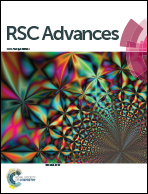Solvothermal syntheses of lanthanide thiogermanates displaying three new structural moieties†
Abstract
A series of lanthanide thiogermanates [Ln(dien)3]2[Ge2S6]Cl2 [Ln = Pr (Ia), Sm (Ib), Gd (Ic), Dy (Id); dien = diethylenetriamine], [Er2(dien)4(μ-OH)2][Ge2S6] (II) and [Ho(trien)(en)GeS3(SH)] (III, trien = triethylenetetramine, en = ethylenediamine) have been hydrothermally synthesized and structurally characterized. The structures of Ia–d consist of isolated [Ln(dien)3]3+ cations, [Ge2S6]4− anions built up from the connection of two [GeS4] tetrahedra sharing a common edge and Cl− ions. II contains binuclear [Er2(dien)4(μ-OH)2]4+ cations constructed by the linkage of [Er(dien)2]3+ ions and –OH bridging groups, and [Ge2S6]4− anions. III contains neutral holmium-centred complexes, where the unusual protonated tetrahedral anion [GeS3(SH)]3− acts as a chelating ligand to complex the [Ho(en)(trien)]3+ cation. A systematic investigation of six lanthanide thiogermanates and four reported compounds revealed that both the well-known lanthanide contraction and different chelating organic amines have a significant influence on the formation of lanthanide thiogermanates under solvothermal conditions. Density functional theory calculation for III has also been performed and the absorption edges of all compounds have been investigated by UV-vis spectroscopy.


 Please wait while we load your content...
Please wait while we load your content...